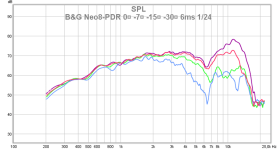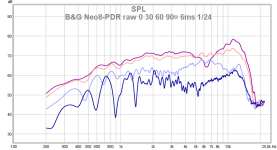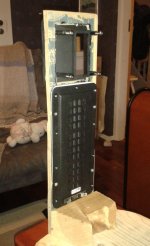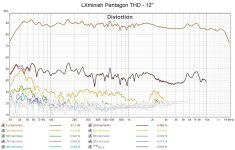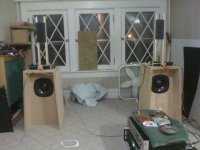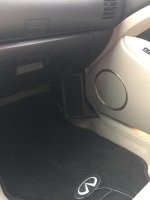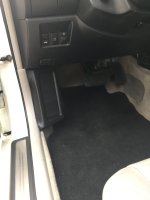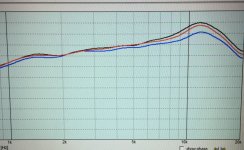So cool! Do the degree that you're interested in replicating LInkwitz' approach, I think that 2nd order lowpass and highpass around 850 to manage the overlap between the woofer and the Neo, and time delay on the woofer per the setback of the Neo would provide the sort of transition he wanted from omnidirectional to cardioid to the tweeter characteristic. You should then be able to independently adjust the two cutoff frequencies to eliminate any dips or bumps in the crossover region.
An issue with LXMinis is some distortion around 1KHz which seems to come from the fullrange/tweeter. There's at least one alternative DSP filter set to tame it. It would be really cool if there were alternative drivers that don't have this issue.
An issue with LXMinis is some distortion around 1KHz which seems to come from the fullrange/tweeter. There's at least one alternative DSP filter set to tame it. It would be really cool if there were alternative drivers that don't have this issue.
Yes, lots to play with, measure & listen. 😉So cool! Do the degree that you're interested in replicating LInkwitz' approach, I think that 2nd order lowpass and highpass around 850 to manage the overlap between the woofer and the Neo, and time delay on the woofer per the....
This was not evident in my early sweeps, on either driver or the system. Didn't have a chance to study closely yet. But...An issue with LXMinis is some distortion around 1KHz which seems to come from the fullrange/tweeter.
I was out -- dinner, then heard a live amplified band and a 1st nations drum band outdoors for a couple of hours. It was decent quality PA, not the best I've heard, but much better than the worst. The drums needed no amplification.
When I got back, I checked the new speaker which had been left for several hours on playing Tidal, a song list begun with a percussive lively jazz piece. I figured that type of music would go far ensuring good break-in of the drivers. Volume was set so peaks were ~90 dB. The speaker was set near the middle of the room where I positioned them for testing.
Another percussive lively jazz piece was playing while I groped for the light switch. The heft and impact of some staccato kick drums in the music was quite shocking, especially when I turned on the lights on this single modest sized speaker. Even the big spatial illusion of dipole was already there with this single speaker in mono.
I'm eager to hear the pair in stereo! Race to get #2 finished by the weekend.
My thoughts on the neo8 were that as it stands, in a passive speaker, in doesn't have the top end to be tweeterless. As I stated, in my car, active with a miniDSP, it'll work just fine.
You are using it actively, so I bet your project is sounding pretty good. Looking pretty cool, too.
You are using it actively, so I bet your project is sounding pretty good. Looking pretty cool, too.
Ah I see.My thoughts on the neo8 were that as it stands, in a passive speaker, in doesn't have the top end to be tweeterless. As I stated, in my car, active with a miniDSP, it'll work just fine.
Yes, it sounds good, hopefully it can get better with more precise execution of the crossover & EQ. I suspect the exact location of the tweeter (further back or closer...) is not critical.You are using it actively, so I bet your project is sounding pretty good. Looking pretty cool, too.
(The speaker is driven by a PC source with JRiver, Tidal, Qobuz, and sometimes, youtube. Goes via USB to a Topping D10, which then gives SPDIF via RCA out to the minidsp 2x4 HD. Amps are 4 ch of a Rotel 1048 (40Wx8) AB amp. Its sounds ok, not as transparent or powerful as the Hypex nCores, but pretty good.)
By compensation, do you mean EQ boost in the treble or...?B&G Neo8 has narrow vertical directivity, which "needs" compensation in on-axis spl to sound right at normal listening distance.
Is the first graph you posted vertical directivity & the second horizontal?
Haven't done any off axis sweeps yet. My 6 degrees tilt back might help.
Have you tried reducing the vertical height of the Neo8 using triangular shape open cell foam? 2 blocks, each about 2.5-3" long blocking the upper and lower face of the Neo8, leaving only the central 2-3" unimpeded. It would have increasing effect on higher frequencies, and overall, should increase vertical directivity. If it works, the backside could be treated similarly.
Since the neo8 sensitivity requires reducing output by 7~9 dB to match the Seas woofer, the reduction in its output might even be beneficial.
Last edited:
Neo8 has boosted treble on-axis, which compensates for beaming, in total sound power. But beaming can be heard.
Yes, first graph is vertical, right one horizontal off-axis. Those are from 2013, in test baffle. I lowpass Neo8 around 3500Hz, so I haven't tried foam or other trick with its. But I use felt pads to expand Neo3's radiation!
I think that Neo8 can work OK without a tweeter, and foam or felt blocks are worth testing! Rearside symmetry is not terribly important, if you want to keep it simple...
Yes, first graph is vertical, right one horizontal off-axis. Those are from 2013, in test baffle. I lowpass Neo8 around 3500Hz, so I haven't tried foam or other trick with its. But I use felt pads to expand Neo3's radiation!
I think that Neo8 can work OK without a tweeter, and foam or felt blocks are worth testing! Rearside symmetry is not terribly important, if you want to keep it simple...
The 2nd box is glued up but needs a lot of fine detailed work. Meanwhile, I've made a change to the way the Neo8 is mounted on the 1st tower. It's less physical imedance than before. Of course, the rear pointed tail of the baffle was also removed. The tilt is now 6 degrees -- 1 degree change, probably not audible.


I had applied a bunch of filters in the minidsp 2x4 HD yesterday based on 1m measurements, but decided to start from scratch with the new Neo8 mounting.
Tried 2nd order for woofer, then tweeter, then played with xover points from 750Hz to about 1kHz. A few measurements but none kept -- I kept going back to the B1 filter @850, so decided to keep it there.
WOOFER EQ: A +5 dB Q=1.3 boost @ 50Hz brought up the bass nicely, both measured and heard. Later, I used a narrow Q=5 -16 dB cut at 6100Hz to get rid of the metal bass cone breakup.
TWEETER: Applied -4 dB Q=1.2 cut @11kHz to tame the on-axis peak, and +3 dB Q=1 boost @4300 Hz.
All 1m measurements had this deep suckout centered around 110 dB, which I didn't really hear. It is still there at 1' -- and 8' @ 30 degrees off axis where I'm seated at the control desk.
I tried some wedge shaped foam pieces covering the top and bottom portions of the Neo8 to increase vertical dispersion, but after half an hour of measurements and listening, decided they weren't worth the trouble. Forgot to take pics.
REW screen captures for the above added.
For distortion measurements, the amplitude is about 6 dB less at 1m, so mid 80s. Overall distortion is modest, even with the bass boost. I did hit 96-98 dB peaks around 50 Hz in music and noticed a bit of audible distortion compared to lower volume settings. I'd guess around 100 dB @ 1m is probably a safe max in the bass for these speakers -- in my fairly well damped ~4000 cubic ft room.
I had applied a bunch of filters in the minidsp 2x4 HD yesterday based on 1m measurements, but decided to start from scratch with the new Neo8 mounting.
Tried 2nd order for woofer, then tweeter, then played with xover points from 750Hz to about 1kHz. A few measurements but none kept -- I kept going back to the B1 filter @850, so decided to keep it there.
WOOFER EQ: A +5 dB Q=1.3 boost @ 50Hz brought up the bass nicely, both measured and heard. Later, I used a narrow Q=5 -16 dB cut at 6100Hz to get rid of the metal bass cone breakup.
TWEETER: Applied -4 dB Q=1.2 cut @11kHz to tame the on-axis peak, and +3 dB Q=1 boost @4300 Hz.
All 1m measurements had this deep suckout centered around 110 dB, which I didn't really hear. It is still there at 1' -- and 8' @ 30 degrees off axis where I'm seated at the control desk.
I tried some wedge shaped foam pieces covering the top and bottom portions of the Neo8 to increase vertical dispersion, but after half an hour of measurements and listening, decided they weren't worth the trouble. Forgot to take pics.
REW screen captures for the above added.
For distortion measurements, the amplitude is about 6 dB less at 1m, so mid 80s. Overall distortion is modest, even with the bass boost. I did hit 96-98 dB peaks around 50 Hz in music and noticed a bit of audible distortion compared to lower volume settings. I'd guess around 100 dB @ 1m is probably a safe max in the bass for these speakers -- in my fairly well damped ~4000 cubic ft room.
Attachments
Last edited:
One more change I just applied -- 6 dB Q=2 boost at 20 kHz in case anyone can hear up that high. I'm pretty sure my sensitivity >15 kHz is quite reduced.
Made no difference at all in the measured response at my seated position. 😆
Turned that off & turned on a cut of -3 dB@ 7.5 kHz which tamed that brightness.
Made no difference at all in the measured response at my seated position. 😆
Turned that off & turned on a cut of -3 dB@ 7.5 kHz which tamed that brightness.
Last edited:
Listening to more jazz Tidal is pushing at me -- it's all sounding pretty amazing. Still one speaker, still mono.
The breathy sax in Angel Eyes by Markus Phillippe is very convincing.
My measurements obviously don't tell all. I still need to do off axis measurements. Drag out the angle platform...
The breathy sax in Angel Eyes by Markus Phillippe is very convincing.
My measurements obviously don't tell all. I still need to do off axis measurements. Drag out the angle platform...
I am listening to lx minis right now. Really impressive speakers, better than I remember them being. Surprising bass, fast, with that immersive soundstage. I have a feeling your neo 8s are a wonderful alternative.
I would like to try open baffle speakers I've never heard a pair been curious now for a few years. But I have a friend who is a bass player a really good bass guitar player. And he hates open baffle says the bass is too fast. He said he even listens to his own baselines through open baffle and it sounds sped up even though it's not. Not trying to second-guess my friend he's made a really good living and has bought a really nice home playing bass guitar so I'd like to think that he would be an expert in the field of Bass since he's made his living off of it. At the same time I know people will see something and just hate it for reasons maybe they don't even know themselves so is my friend wrong about the base sounding too fast on open baffle speakers and not being realistic?
Part GRS PT6825-8 -- 8" Planar Mid/Tweeter 8 Ohm But my FR curves show its output falls off quite rapidly a bit below 1kHz, at least the way I'm running it, w/o baffle & in dipole mode. This is quite different from the factory spec, which shows usable output all the way to ~200 Hz. I might try a pair of the smaller Neo3, which is supposed to be flat to about 600Hz, and spec'd for 800~20kHz.There are two neo8’s. One is a mid unit, and the other a tweeter. Mike is using the tweeter
Aren't most guitar speaker/amps open back? If not open back, then at leas aperiodic. Surely that would be the kind of sound he heard when he started playing bass -- I assume electric bass?I would like to try open baffle speakers I've never heard a pair been curious now for a few years. But I have a friend who is a bass player a really good bass guitar player. And he hates open baffle says the bass is too fast. He said he even listens to his own baselines through open baffle and it sounds sped up even though it's not. Not trying to second-guess my friend he's made a really good living and has bought a really nice home playing bass guitar so I'd like to think that he would be an expert in the field of Bass since he's made his living off of it. At the same time I know people will see something and just hate it for reasons maybe they don't even know themselves so is my friend wrong about the base sounding too fast on open baffle speakers and not being realistic?
A DIY audio buddy in Vancouver who also frequents these forums is kind of hooked on dipole bass. Doesn't want anything else -- at least till recently, when horns started their siren call on him. His take is that it's way more natural than the artificial punchiness of most other bass loading configs. And it's not because he listens to unamplified music; on the contrary, his favorite music is Italian bleeding edge rock opera. But recently, he's talking about moving to a BI-pole bass system.
Until the Linkwitz Orions I built nearly a decade ago, my reference for bass performance was the Linn Isobarik in active mode with Naim amps. But I've come to prefer OB bass too. It is indeed "more natural", with less of that thump in the chest thing you get with the pressurizing of the room space by quick volume displacement. My LX521-inspired speakers are even better in this regard, with SB Acoustics 10" NRX woofers -- which are a bargain for their excellent performance. My next door neighbor, a prof drummer now touring the US with a big time rock band Tears for Fears, loves the bass of my LX521-inspired dipoles as well. Aside from bass, I've become so accustomed to the big imaging and non-critical listening position of my OBs that I doubt I can live long term with something else.
The Seas LX18 variant bass driver I'm using here aren't big enough to exhibit a lot of that room air displacement effect, but have quite authentic bass within limits -- ie, not super low, not real loud. The little cone pumps pretty hard playing anything <50Hz at >90 dB. The fella who sold them said they were optimized for low bass performance, but the Q and Fs data from my testing don't suggest they'd do that well. Maybe once they're broken in enough those numbers -- and perceived performance -- will improve.
Electric bass is typically played with a closed back cabinet, as far as I know. That is going to have a different decay in-room vs. dipole. Since most of the speakers in the world are not dipoles, there's no reason for an amplified musician to be interested in this kind of speaker. It's not going to sound like what they're used to/practice with, so I can see it being a non-starter for them.And he hates open baffle says the bass is too fast.
For standard electric guitar, many are. For serious electric bass guitar, I don't think so, but I'm not a musician.Aren't most guitar speaker/amps open back?
Last edited:
- Home
- Loudspeakers
- Multi-Way
- A “Good Enough” OB/Sealed Hybrid for “Everyman”?
